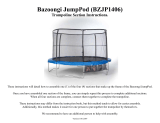
Bazoongi JumpPod (BZJP1206)
Trampoline Section Instructions.
These instructions will detail how to assemble one (1) of the four (4) sections that make up the frame of the Bazoongi JumpPod.
Once you have assembled one section of the frame, you can simply repeat this process to complete additional sections.
When all four sections are complete, connect them together to complete the trampoline.
These instructions may differ from the instruction book, but this method tends to allow for easier assembly.
Additionally, this method makes it easier for one person to put together the trampoline by themselves.
We recommend to have an additional person to help with assembly.
Version 10192007

Here is one (1) of four (4) sections of the JumpPod.
Note: You will need to distinguish the differences between the frame pieces you have with your trampoline
and lay them out in the same way as shown above.
In the next page we will take a look at the differences between these frame pieces.
“J-Leg” Shorter
“J-Leg” Longer
“Leg Center”
“Pod Connector” (Large)
2
“T-Connector”

3
Now let’s take a look at each tube seperately beginning with the rst tube (far right).
The difference between the Shorter J-Leg (Blue) and the Longer J-Leg (Red) is
the length of the straight piece that inserts into the connectors as shown above.

Note: The “underside” has two (2) holes and
the “top” has three (3) holes.
The side that goes into the support socket
(as pictured, above) is opposite the side with the
T-Connector (enlarged picture).
4
“Underside”
“Top of Tube”
“T-Connector”

Moving on to the next tube...
This tube should come with the support socket attached.
It has two (2) holes on the “underside” and three (3) holes on the “top” side.
“Support Socket”
“Underside”
“Top”
5

Moving on to the nal tube...
This tube should come with the POD Connector (Large T-Connector) attached.
It has two (2) holes on the “underside” and three (3) holes on the “top” side.
“POD Connector”
“Underside”
“Top”
6

Before connecting the top tube pieces make sure all tubes have been identied and laid out in the same
conguration as show on Page 2. Next, connect all the top tubes pieces together as shown below.
Here we have already inserted the leg center into the
longer “J-Leg”. Be sure to properly align the screw
holes before connecting these two pieces together.
7

To attach the leg section:
(Diagram 1):
Insert the straight side of the “J-Leg” and
“Leg Center” that were screwed together
from the previous page.
(Diagram 2):
Insert the “J-side” (shorter) into the assem-
bly from the previous step. REMEMBER
to align the screw holes and insert the self
tapping screws into the leg as shown.
(Diagram 3):
Now insert the straight side of the “J-Leg”
of the entire leg piece into the POD Con-
nector. Note: In order for the leg to prop-
erly t into the entire frame of the trampo-
line, the leg may need to be “pulled” over
to t into the connector.
8
Now onto the Leg Section . . .
Diagram 1
Diagram 2
Attach here with “self tapping screws”
Insert here
Diagram 3
Insert here

When all the legs are complete, arrange them on the ground in a circle with the legs facing upwards.
9

Diagram 1: Now take two sections of completed legs and ip them over and rotate them 180º.
Diagram 2: Next, connect these two sets of legs together at the T-connector of one and the open tube of the other.
Diagram 3: Now, ip over, rotate, and connect the next leg set to the complete previous sets.
Diagram 4: Finally, ip over, rotate, and connect the nal leg set to complete the ring of the trampoline frame.
10
Diagram 1 Diagram 2
Diagram 3 Diagram 4
-
 1
1
-
 2
2
-
 3
3
-
 4
4
-
 5
5
-
 6
6
-
 7
7
-
 8
8
-
 9
9
-
 10
10
Jumpking Jump Pod Assembly Instructions
- Type
- Assembly Instructions
- This manual is also suitable for
Ask a question and I''ll find the answer in the document
Finding information in a document is now easier with AI
Related papers
-
 Bazoongi BZJP1506 Assembly Instructions
Bazoongi BZJP1506 Assembly Instructions
-
Jumpking JP1514 User manual
-
Jumpking JK1331 Owner's manual
-
Jumpking JP1514C Owner's manual
-
Jumpking Safety Pad Attachment for Round Trampolines Owner's manual
-
Jumpking JP1414C Owner's manual
-
 Bazoongi BZJP1406 Assembly Instructions
Bazoongi BZJP1406 Assembly Instructions
-
Jumpking BZJP1406 Owner's manual
-
Jumpking BZJP1206 Owner's manual
-
Jumpking JK1331 Owner's manual














